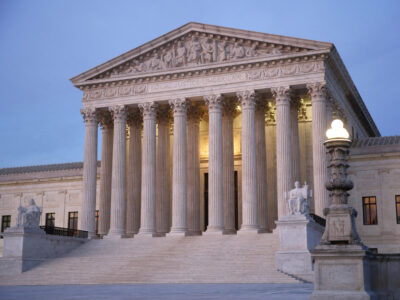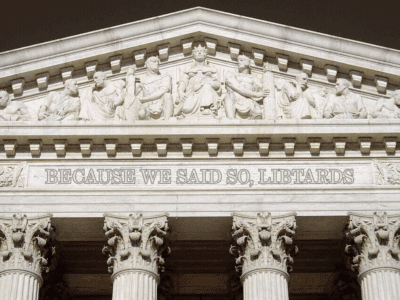The U.S. Supreme Court & Environmental Law in 2024
Numerous Key Environmental Issues and Doctrines Will Confront the Justices This Year

As we begin 2024, it’s useful to identify and assess the many environmental issues that the U.S. Supreme Court has agreed to decide this year. It seems likely that the conservative majority of the justices will erode or, perhaps, dramatically jettison longstanding principles of environmental law and policy in the coming months.
Summarized below are the cases that the justices have already taken up and will decide this year. (I’ve included links to the relevant pages of the excellent ScotusBlog.com website, for those interested in more information about each of the following cases; there readers can easily access more detailed summaries of the pending cases, the lower court decisions from which Supreme Court review has been granted, and the legal arguments presented to the justices by attorneys for each side and their supporters.)
Sheetz v. County of El Dorado, California, U.S.S.C. No. 22-1074 First up before the Court in 2024 is this “regulatory takings” case from California. I profiled the Sheetz case in an earlier Legal Planet post when the justices granted review in late 2023. Briefly, Mr. Sheetz challenges as an unconstitutional taking of his property a broadly applicable “traffic impact mitigation fee” imposed by El Dorado County as a condition of granting Sheetz a permit to build a single family home on his land. Over the past four decades, U.S. Supreme Court decisions have developed the so-called “unconstitutional conditions” sub-doctrine of regulatory takings law, but to date have only applied it to individually-negotiated land use permit conditions and fees. California state courts–including in the Sheetz case–have consistently refused to extend the doctrine to broadly-applicable fees and conditions imposed on landowners in exchange for their obtaining development approvals–so-called “quasi-legislative” fees and conditions.
In Sheetz, the landowner argues that the doctrine should be expanded to quasi-legislative fees like the one assessed against him. While it’s unclear to this observer whether and how regulatory takings rules can effectively be applied in the quasi-legislative context, the facts of the Sheetz case are not particularly favorable to the government defendants. And in recent years the Supreme Court has moved steadily to the right when it comes to the inevitable tension between constitutionally-protected private property rights and traditional government land use regulation. So El Dorado County appears to be facing an uphill battle in the Sheetz case. The justices will hear oral arguments on January 8th.
Loper Bright Enterprises v. Raimondo, No. 22-451, consolidated with Relentless v. Department of Commerce, No. 22-1219 These cases arise out of a legal challenge by commercial fishing companies to a federal fisheries regulation requiring private fishing boats to allow onboard (and pay for) federal observers to monitor their fishing practices–primarily to ensure that the boat operators don’t exceed federally-prescribed fishing “catch” limits. An environmental law dispute to be sure, but relatively mundane stuff.
However, the underlying and far more important feature of these cases is the companies’ challenge to the so-called “Chevron Doctrine.” The Supreme Court itself announced it in a landmark 1984 Clean Air Act decision that over the past 40 years has become a cornerstone principle of modern administrative law. The Chevron Doctrine provides that where Congress itself hasn’t explicitly explained what a federal statutory provision means, the courts should generally defer to the interpretation of that provision reached by the federal agency that Congress has directed to administer the law.
The Chevron Doctrine has always been somewhat controversial. But in recent years a number of the Supreme Court’s conservative justices have written opinions declaring that the doctrine is fundamentally ill-conceived and should be overruled. And many conservative legislators, scholars and political activists complain that the Chevron Doctrine is a key component of the dreaded Administrative State, one that should be nullified. It appears that a majority of the current justices may well be prepared to do just that in the Loper Bright and Relentless cases, which are scheduled for oral argument on January 17th.
Securities & Exchange Commission v. Jarkesy, No. 22-859 The Jarkesy case directly involves federal regulation of securities markets–not environmental law. But the case could have a profound impact on federal enforcement of the nation’s environmental laws.
The Securities & Exchange Commission pursued a civil administrative enforcement case against hedge fund operator Jarkesy, ultimately assessing a civil fine of $300,000 and ordering him to disgorge and repay nearly $700,000 in ill-gotten gains. Jarkesy challenged the administrative decision in federal court, relying on three separate constitutional theories and prevailing in the U.S. Court of Appeals. The Supreme Court granted review.
Why is the Jarkesy case important to environmental law and lawyers? Because administrative enforcement proceedings by the U.S. Environmental Protection Agency and other environmental agencies are a key component of federal environmental enforcement efforts. For a half-century, environmental regulators have had the option to prosecute perceived federal environmental violations either by filing a federal lawsuit or, alternatively, pursuing the violation administratively using administrative hearing officers. (The target of an administrative enforcement action does have the right to seek judicial review of an adverse administrative ruling.)
The Supreme Court heard oral arguments in the Jarkesy case on November 29th. Of the constitutional arguments mounted against administrative enforcement, the one that garnered the most traction with the justices was that administrative proceedings using administrative hearing officers violate a party’s Seventh Amendment-based right to a jury trial in civil cases. And Jarkesy’s argument that the SEC’s use of administrative proceedings deprived him of his Seventh Amendment rights seemed to resonate with the conservative wing of the Court.
Depending on how broadly the justices rule in any decision favoring Jarkesy, the adverse impact on. federal enforcement of environmental laws could be just as dramatic as civil prosecution of federal securities law violations. And since most environmental enforcement actions are brought administratively rather than in the courts, the adverse consequences such a ruling would have on a vigorous federal environmental enforcement program may well be substantial.
Clean Air Act “Good Neighbor Rule” Litigation Finally and most recently, the Supreme Court on December 20th exercised its “Shadow Docket” powers to take up four related lawsuits challenging USEPA’s so-called “Good Neighbor Rule” under the federal Clean Air Act. Under that rule, EPA has directed 23 Western and Midwestern states to take measures to ensure that their air emissions of nitrogen oxide don’t adversely affect air quality in “downwind” states in the Eastern U.S. Last February, EPA determined that the 23 targeted states previously had failed to do so, and adopted its own “Good Neighbor Rule.”
The states of West Virginia, Ohio and Indiana–joined by energy companies and industry trade groups–promptly sued EPA in the D.C. Circuit Court of Appeals. But when that court declined to stay EPA’s Good Neighbor Rule while it considered the merits of the rule, the plaintiffs asked the Supreme Court to intervene. The justices neither granted the plaintiffs’ stay request nor announced it would hear these cases on their merits. Remarkably, it instead determined in late December that it would hear oral arguments in February on whether it should suspend EPA’s Good Neighbor Rule while the lower court lawsuits play out.
In sum, the Supreme Court has a number of critically important environmental cases on its current docket. Each of these matters will likely be decided by the end of June 2024. (Of course, the justices may well decide to take up still more environmental law cases in 2024; but it’s likely that any additional cases won’t be argued until this Fall, with decisions deferred until the first part of 2025.)







Reader Comments